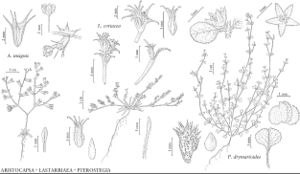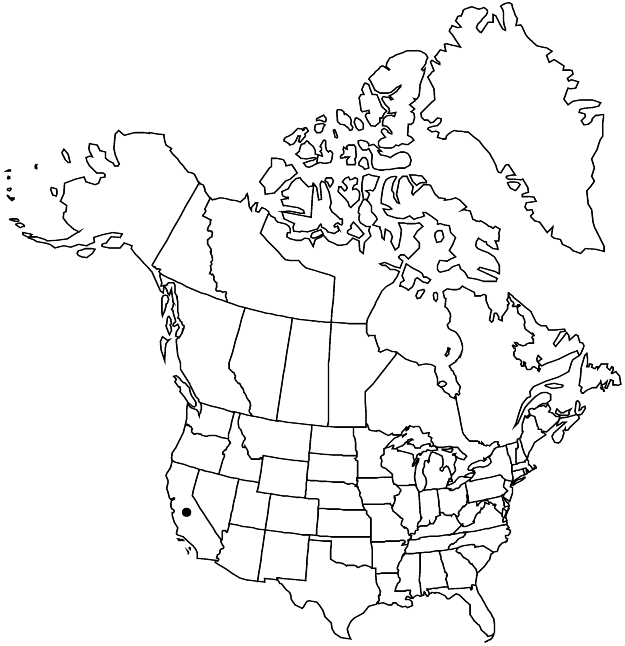familyPolygonaceae
subfamilyPolygonaceae subfam. Eriogonoideae
genusAristocapsa
speciesAristocapsa insignis
Aristocapsa insignis
Phytologia 66: 84. 1989.
IllustratedEndemicConservation concern
Basionym: Chorizanthe insignis Curran Bull. Calif. Acad. Sci. 1: 275. 1885
Synonyms: Centrostegia insignis (Curran) A. Heller Oxytheca insignis (Curran) Goodman
Treatment appears in FNA Volume 5. Treatment on page 476.
Plants 0.2–1 × 0.2–0.8 dm. Leaf-blades (0.3–) 0.5–1.5 × (0.1–) 0.2–0.4 cm. Peduncles 1–2 mm. Involucres 3–5 mm, faintly corrugate; awns divergent, (1–) 2–3 mm. Flowers 1.5 mm; filaments 1.5–2 mm. Achenes 1.5 mm. 2n = 28.
Phenology: Flowering May–Jun.
Habitat: Sandy soil in grassland communities, and in pine-oak or juniper woodlands
Elevation: 300-600 m
Discussion
Of conservation concern.
Selected References
None.
Lower Taxa
None.
"/2" is not declared as a valid unit of measurement for this property."dm" is not declared as a valid unit of measurement for this property.
... more about "Aristocapsa insignis"
not winged +
brown;tan +
included +
glabrous +
homocarpic +
3-gonous +
dehiscing +
oblong +
divergent +
absent +
rosulate +
distal +
stipelike +
linear-spatulate +
awn-tipped +
entire +
connate +
absent +
2;10 +
connate +
not brittle +
free +
aerial +
round +
woody +
Calif. +
curved +
nuclear +
abundant +
free +
glabrous +
1.5 cm15 mm <br />0.015 m <br /> (?) +
aerial +
fistulose +
homocarpic +
Present +
bractlike +
cymose +
capitate +
racemose +
axillary +
enclosed +
5-ribbed +
opposite +
corrugate +
nonmembranous +
0.2cm;0.4cm +
deciduous +
bractlike +
awn-tipped +
long-awned +
connate +
not swollen +
orthotropous +
basal +
articulate +
absent +
accrescent +
peglike +
cluster +
erect +
absent +
erect to deflexed +
winged +
white;pink or rose +
persistent +
pubescent +
pustulose +
accrescent +
absent +
indistinct +
Phytologia +
1989 +
fibrous +
ringlike +
longitudinal +
recurved +
absent +
scandent +
absent +
not fistulose +
peltate +
capitate +
foliaceous +
absent +
chartaceous +
arranged +
involucral +
absent +
distinct +
erect;spreading or recurved +
spreading;erect +
slender +
Aristocapsa insignis +
Aristocapsa +
species +
absent +
monomorphic +
entire +
connate +
dimorphic +
coriaceous +
awn-tipped +
erect +
persistent +
membranous +
glandular-punctate +
developing +
raised +
homophyllous +
annual +
polycarpic +
0.2dm;0.8dm +

